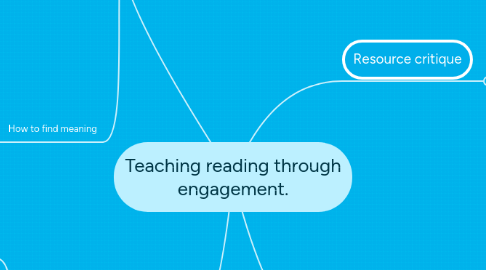
1. Teacher observations
1.1. Specific learning focus
1.1.1. "AGO" aims goals and objectives
1.1.2. Learning based around inquiry
1.1.3. Literacy groups based around central idea, included literacy goal.
1.2. Frequent checking for understand
1.3. Up to date running records
1.3.1. Ensuring adequate challenge
1.3.2. Checking understanding
1.4. Encouragement
1.4.1. Engagement
1.4.2. Confidence
2. Skills
2.1. How to figure out a new word
2.1.1. Break down word
2.1.2. Sound out
2.1.3. Get mouth ready for sounds of word
2.1.3.1. Lips of a fish
2.1.4. Reread
2.1.5. Read on
2.1.6. Make meaning
2.1.6.1. Reading on
2.1.6.2. Looking at image, if one
2.1.6.3. Meaning of word
2.1.6.4. Does it make sense with word next to it
2.1.6.5. Add in a word that can make sense with sentence and see if it makes sense in paragraph
2.1.7. Find words we do know inside bigger word
2.1.8. Do we know any similar words
2.1.9. Decoding
2.2. How to find meaning
2.2.1. What happened in the text?
2.2.2. How do you feel about what happened?
2.2.3. Who were the characters
2.2.3.1. Describe certain character
2.2.3.2. Describe characters relationships
2.2.3.3. Who's point of view was it from?
2.2.4. What type of text was it?
2.2.4.1. Informative
2.2.4.2. Report
2.2.4.3. Narrative
2.2.4.4. Entertainment
2.2.4.5. Explanatory
2.2.5. Can you summarize what happened?
2.2.6. Can you apply prior knowledge?
2.2.6.1. Describe what may happen by looking at front cover
2.2.6.2. Describe what may happen after reading half the book
3. Resource critique
3.1. What to do when you're stuck on a word poster
3.1.1. Student made: allows students to help each other with tips on how to work out words
3.1.2. A place to look whenever confused and something doesn't make sense
3.1.3. If always using the same steps to do something it will stick in their mind and remember cues.
3.2. Reading corner
3.2.1. A quiet comfortable place for students to work
3.2.2. Creates a positive space for students to engage in reading
3.2.3. May cause problems if too many people want to use it
3.3. Comprehension prompt cards
3.3.1. Good to allow students to look at when trying to make connections with text
3.3.2. A good resource to use before and after reading
3.3.3. Another good tool that with frequent use students will start associating these questions with everything they read
4. Classroom resources
4.1. Books
4.1.1. Dictionaries
4.1.2. Different leveled books
4.1.3. Teacher books
4.1.3.1. Big books
4.1.3.2. Literacy circle books
4.1.4. Informative and story books
4.2. Posters
4.2.1. Student made showing learning
4.2.2. Teacher resource with specific purpose
4.3. Computers
4.3.1. Online texts
4.3.2. Other forms of literacy
4.3.2.1. Power point
4.3.2.2. Websites
4.3.2.3. Word files
4.3.2.3.1. "publishing"
